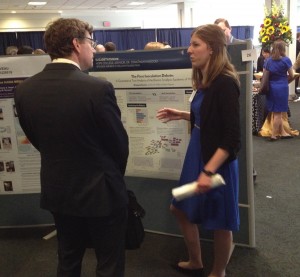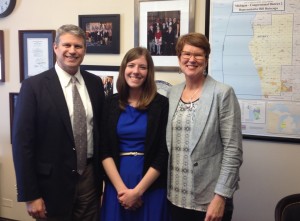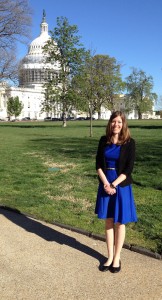A heated debate rooted in a distrust of science about the safety and effects of childhood vaccinations has, in recent years, been under a microscope in this country. But another inoculation debate raged in the U.S. almost 300 years ago, and it was this tense, centuries-old discourse, rooted this time in both scientific and religious misgivings, that became junior Elizabeth Ensink’s research focus during the summer of 2015. Her original work on the topic earned her a prestigious place at last week’s 20th annual national Posters on the Hill event in Washington, DC, a selective poster session sponsored by the Council on Undergraduate Research (CUR).

One of only 60 projects selected for this year’s showcase from among several hundred highly competitive applications nationwide, “The First Inoculation Debate: A Quantitative Text Analysis of the Boston Smallpox Epidemic of 1721” by Ensink, looks at communication practices between doctors and religious leaders when a smallpox epidemic broke out in Boston. Puritan ministers saw inoculation as distrust in and interference with God’s will; doctors fumed at the meddling of ministers and “unlearned men” in scientific affairs; and all the while colonists, fearing for their lives, just wanted people in positions of authority to give them clear words of encouragement and actions of help.
It all sounds so familiar even today. History tends to eerily, annoyingly repeat itself.
Ensink, who is from Hudsonville, MI, became interested in the inoculation topic when looking through the digital Contagion Collection – historical documents about various epidemics and diseases – from Harvard. As a Mellon Scholar, she was set to conduct summer research after her sophomore year, and as a biology and creative writing double major, Ensink felt she found the right subject for her interdisciplinary interests.
So, using digitized documents and an online text analysis tool called Voyant, Ensink analyzed words that pro- and anti-inoculators would frequently used in their letters and other documents – words such as God, belief, providence, and symptoms, infection and incision. Not surprisingly, she found that doctors used mostly secular language and ministers spoke more in religious terms. All except for Cotton Mather.
“This subject showed me how important it is to have people know how to communicate science to the general public. One of the most important parts of my research was questioning how we get meaning from words that are being used to convey vital messages.”
Mather, the fiery Puritan minister best known for his involvement in the Salem witch trials, was supportive of inoculation when he learned of it from his African slave and a report from the Royal Society of London, Ensink learned. Mather then encouraged Dr. Zabdiel Boylston to start inoculations. Though the practice was successful – 6,000 infected, 844 deaths overall, 280 saved due to inoculation –Mather and Boylston came under attack for the practice. And often it was because of the words they did or did not use.
“This subject showed me how important it is to have people know how to communicate science to the general public,” says Ensink. “One of the most important parts of my research was questioning how we get meaning from words that are being used to convey vital messages. In this case, religious and secular language was often blurred.”
Ensink presented those findings with her poster for two hours in the Rayburn Building on Capitol Hill, where she also had the opportunity to engage with other students from Georgia to Utah, about biochemistry and anthropology and other various subjects. “This event exposed me to diverse projects and people from diverse institutions. It was an honor.”

After the prevention of her poster on the Hill, Ensink and Dr. Karen Nordell Pearson, associate dean for research and scholarship, had the opportunity to meet with Congressman Bill Huizenga at his office in the Capitol. “It’s really cool that in America we can go and talk to our representatives in government about what we think is important. “
And what did they talk about?
“I told him that undergraduate research should continue to receive federal funding. Events like Posters on the Hill show what students can do when funds are available.

“I also let him know how important programs like Mellon Scholars are to undergraduates. Being in Mellon allowed me to develop my own project, gave me greater critical thinking skills and a great mentor who I met with twice a week.” Ensink’s mentor, Dr. Jonathan Hagood, is an associate professor of history at Hope College. “I learned self-motivation and the ability to overcome obstacles. This work stretched me and confirmed that in the future I want to focus on science and writing.”
In every way, Ensink’s research, and her experiences because of it, have given a potent shot to her strong academic arm. “I’m so thankful for the Mellon Scholars Program for all of this,” she concludes.

